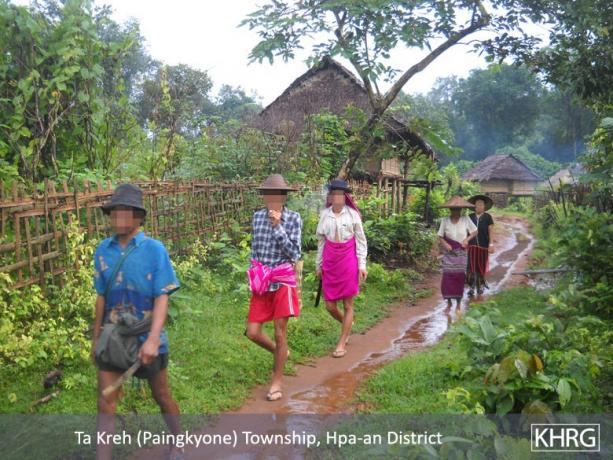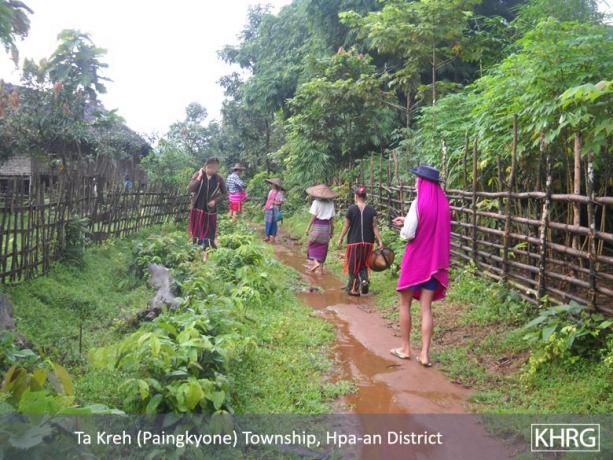This report includes a situation update submitted to KHRG in November 2011 by a community member describing events that occurred in Pa'an District in September 2011. It contains updated information concerning military activity, specifically Border Guard and Tatmadaw troops' demands for villagers to provide forced labour. Villagers from Eg--- were ordered by Border Guard troops to repair the vehicle road between Eg--- and M---, and were forced to clear vegetation from Border Guard Advisor Hpah Nwee's rubber plantation – an incident that was previously reported by KHRG in June 2012 in "Pa'an Interview: Saw T---, September 2011". Villagers who were sick or could not spare the time to meet the forced labour demands had to hire other villagers to work in their place, highlighting how such demands can prevent villagers from engaging fully in their livelihood activities.
Situation Update | Dta Greh and Lu Pleh Townships, Pa'an District (September 2011)
The following situation update was written by a community member in Pa'an District, and is presented below translated exactly as originally written, save for minor edits for clarity and security.[1] This report was received along with other information from Pa'an District, including three interviews and 82 photographs.[2]
Forced Labour
The photos below are of Eg---villagers. On September 18th 2011 they had to repair the vehicle road for SPDC [Tatmadaw][3] and Border Guard soldiers to allow them to travel back and forth between the villages of Eg---and M---, in Dta Greh and Lu Pleh Townships, respectively. The villagers also had to clear vegetation from the rubber plantation belonging to [Border Guard Advisor] Hpah Nwee. About 20 people from each village had to go, bringing their own packets of rice, knives and mattocks [a versatile hand tool similar to a pickaxe which can be used for digging or chopping]. People estimated that more than 50 villagers gathered together [to do forced labour] each day.
Some villagers did not have time to go and some were sick, so they had to hire other people for 4,000 kyat (US $4.89)[4] per day, instead of going themselves. If it [the forced labour] takes the whole week, the villagers will have to hire people for the whole week, as they have to complete it. I took the photos on September 20th 2011 when I stayed in Eg--- village. I interviewed the villagers who had to go [and do forced labour] themselves regarding this information.[5]
These photos show Eg--- villagers travelling between Eg--- village and Border Guard Advisor Hpah Nwee’s rubber plantation, and the vehicle road where they were forced to do labour for Tatmadaw and Border Guard soldiers. [Photos: KHRG]
Footnotes:
[1] KHRG trains community members in eastern Burma to document individual human rights abuses using a standardised reporting format; conduct interviews with other villagers; and write general updates on the situation in areas with which they are familiar. When writing situation updates, community members are encouraged to summarise recent events, raise issues that they consider to be important, and present their opinions or perspective on abuse and other local dynamics in their area.
[2] In order to increase the transparency of KHRG methodology and more directly communicate the experiences and perspectives of villagers in eastern Burma, KHRG aims to make all field information received available on the KHRG website once it has been processed and translated, subject only to security considerations. As companion to this, a redesigned website will be released in 2012. In the meantime, KHRG's most recently-published field information from Pa'an District can be found in the report, "Pa'an Interview: Saw Hs---, April 2012," KHRG, June 2012.
[3] In Karen, the Burmese phrases Na Ah Pa (SPDC) and Na Wa Ta (SLORC) are commonly used to refer to the Burmese government or to Burma's state army, the Tatmadaw. Many older Karen villagers who were accustomed to using the phrase Na Wa Ta (SLORC) before 1997 continue to use that phrase, even though the SLORC has not officially existed since 1997. Similarly, despite the official dissolution of the SPDC in March 2011, many Karen villagers continue to use the phrase Na Ah Pa (SPDC) to refer to the Burmese government or to the Tatmadaw; see: "Mission Accomplished as SPDC 'dissolved'," Myanmar Times, April 4-10th 2011. The term Na Ah Pa was used by the villager who wrote this report and "SPDC" is therefore retained in the translation of this report.
[4] As of June 5th 2012, all conversion estimates for the kyat in this report are based on a rate of 818 kyat to US $1. This reflects new measures taken by Burma's central bank on April 2nd 2012 to initiate a managed float of the kyat, thus replacing the previous fixed rate of 6.5 kyat to US $1.
[5] The community member who wrote this report is here referring to an interview previously published by KHRG, "Pa'an Interview: Saw T---, September 2011," KHRG June 2012, which was received at the same time as this situation update.











